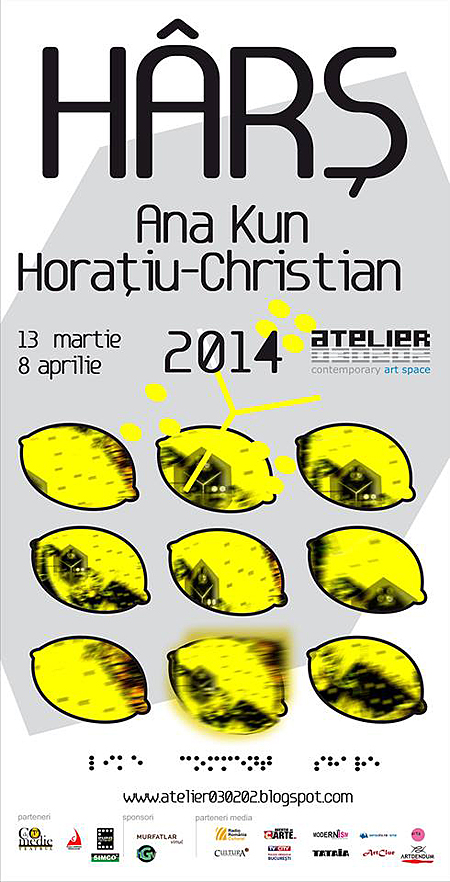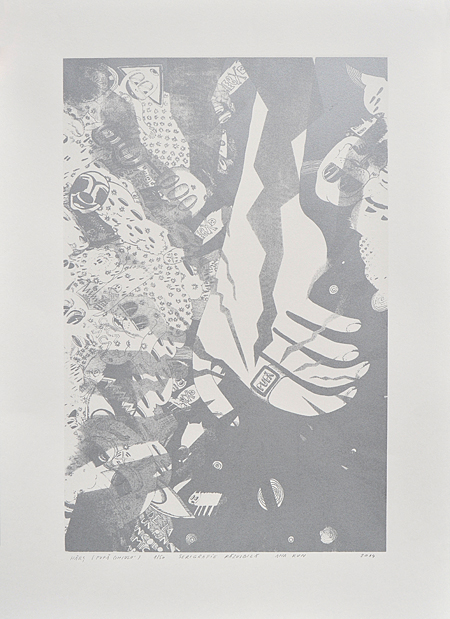
Hârş e un performance colectiv, pornit de la sintagma Răzuiești și Câștigi, în care vizitatorii intervin asupra stratului de vopsea gri ce acoperă imaginile. Pentru privitorul devenit actant răzuirea este un act cathartic ce transformă arta din obiect intangibil în act ludic. Negarea distanţei dintre privitor şi obiectul de artă are drept efect liberalizarea gestului artistic, inducând un sentiment de coparticipare la actul creaţiei.
Seria de lucrări Răzuieşti şi Câştigi (Limonadă), Artă Tată, Pupă, Fan Girl şi Purgatoriu în afara legii a Anei Kun obligă la descoperire, pornind de la detaliu la întreg. Sunt jocuri şăgalnice care, prin câmpul vizual redus, creează senzaţia de intimitate nemijlocită şi îl face pe privitor părtaş la glumă.
Lucrarea Copacul Cunoaşterii/The Tree of Knowledge, a lui Horaţiu Christian, reprezintă un manifest vizual, o reinterpretare a ideii de valoare materială, integrând eclectic scrierea neolitică de pe tăbliţele de la Tărtăria, România, cu imagistica dolarului american, într‑un discurs despre spirit şi materie.
Seria God-like-comment-share, a lui Horaţiu Christian, împărtăşeşte atitudinea co-participativă (artist-actant) a seriei Răzuieşti şi Câştigi, comunicând prin Braille o sintetizare a simbolisticii culturii moderne într-un univers opus virtualului.

Descriere:
Proiectul implică trei faze: în prima, Horaţiu şi Kun tratează pânzele individual, dezvoltând propria iconografie legată de valoare/non-valoare. În a doua fază, pânzele sunt acoperite integral cu un strat de vopsea răzuibilă, obturând astfel imaginea. În a treia, artiştii intervin asupra lucrărilor prin răzuire, relevând parţial din imaginea iniţială, implicit creând o imagine suprapusă, parazitară, prin care devin co‑autori. Privitorii sunt încurajaţi să intervină suplimentar, folosind monede de 1 ban, distrugând o imagine pentru a câştiga alta. În timpul celor trei stadii, lucrarea variază ca număr de autori – cu cât aceştia sunt mai mulţi şi intervenţia lor este mai largă, cu atât lucrarea este mai aproape de starea iniţială, a autorului unic.
Parte din proiect sunt 50 de mape înseriate, conţinând serigrafii imprimate cu cerneală răzuibilă (folosită, în general, la tipărirea lozurilor răzuibile), dotate şi cu două monede de 1 ban.


Hârş (God Like), serigrafie răzuibilă, serie de 50, Horaţiu-Christian, 2014

Hârş (Pupă Ghiulu), serigrafie răzuibilă, serie de 50, Ana Kun, 2014
Hârş is a collective performance based on the phrase Scratch and Win, where the visitors intervene over the gray paint covering the images. To the now actant viewer the scratching is a cathartic process which transforms art from intangible object into playful act. Denying the distance between the viewer and the object of art has the effect of liberating the artistic gesture, inducing a sense of complicity in the act of creation.
Ana Kun’s series, Scratch and Win (Lemonade), Art Dad, Smooch, Fan Girl and Purgatory Outlawed (see Romanian version for the original titles), compels the discovery to start from the details to the whole. They are playful games which, through the reduced visual field, create a sense of intimacy and makes the viewer partaker to the joke.
The work The Tree of Knowledge, by Horaţiu Christian, is a visual manifesto, a reinterpretation of the idea of material value, eclectically integrating the neolithic writing of Tărtăria, with the iconography of the American dollar, to form a discourse on spirit and matter.
Horaţiu Christian‘s God-like-comment-share series shares the artist-actant co-participation theme of the Scratch and Win series, communicating through Braille a synthesis of the modern culture symbolism in a universe which opposes the virtual.
Description:
The Project implies three phase: during the first, Horaţiu and Kun treat the canvases individually, developing a personal iconography dealing with the theme of value/non-value. During the 2nd phase, the canvases are completely covered with a gray coat of paint, completely hiding the image. On the 3rd, the artists and viewers intervene through scratching, using 1 ban coins (the smallest subdivision of the Romanian currency) destroying one image to reveal another. During those three stages, the works varies in its number of authors – the more they are, the larger their intervention, bringing the work to its original state, that of the single author.
Part of the project there’s a series of 50 folders containing signed and numbered screen prints done with a scratchable ink (generally used in the manufacturing of the scratch and win tickets), equipped with 2 coins of 1ban.